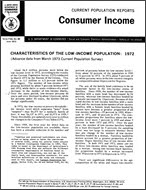
An official website of the United States government
Here’s how you know
Official websites use .gov
A .gov website belongs to an official government organization in the United States.
Secure .gov websites use HTTPS
A lock (
) or https:// means you’ve safely connected to the .gov website. Share sensitive information only on official, secure websites.
-
//
- Census.gov /
- Publications /
- Characteristics of the Low-Income Population: 1972 (Advance Data)
Characteristics of the Low-Income Population: 1972 (Advance data from the March 1973 Current Population Survey)
Characteristics of the Low-Income Population: 1972 (Advance data from the March 1973 Current Population Survey)
About 24.5 million persons were below the low-income level in 1972, according to the results of the Current Population Survey (CPS) conducted in March 1973 by the Bureau of the Census. This figure is 1.1 million or 4.3 percent below the 1971 figure. The number of low-income white persons declined by about 9 percent between 1971 and 1972, while there is some evidence of a small increase in the number of low-income blacks. Over the same period, low-income persons 65 years and over declined by about 12 percent, while for persons under 65, years, the number did not change significantly.
In 1972, the low-income or poverty threshold—the income level which separates "poor" from "nonpoor"—was $4,275 for a nonfarm family of four; it was $4,137 in 1971, and $2,973 in 1959.1 These thresholds are updated every year to reflect the changes in the Consumer Price Index (CPI).
Since 1959, the first year for which data on the low-income population are available, there has been a sizeable reduction in the number and percent of persons below the low-income level—from about 22 percent of the population in 1959 to 12 percent in 1972. In 1972, about 9 percent of all white persons were in the low-income category as compared to about 33 percent for Negroes.
__________
1 Families and unrelated individuals are classified as being above or below the low-income or poverty level, using the poverty index adopted by a Federal lnteragency Committee in 1969, This index is based on the Department of Agriculture's 1961 Economy Food Plan and reflects the different consumption requirements of families based on their size and composition, sex and age of the family head, and farm-nonfarm residence. For more detailed definitions of the terms and concepts used in this report, see Current Population Reports, Series P-23, No. 28 and Series P-60, No. 86.
A Note on Language
Census statistics date back to 1790 and reflect the growth and change of the United States. Past census reports contain some terms that today’s readers may consider obsolete and inappropriate. As part of our goal to be open and transparent with the public, we are improving access to all Census Bureau original publications and statistics, which serve as a guide to the nation's history.
Others in Series
Publication
Publication
Publication
Share
Related Information
Some content on this site is available in several different electronic formats. Some of the files may require a plug-in or additional software to view.
 Yes
Yes
 No
NoComments or suggestions?


Top

